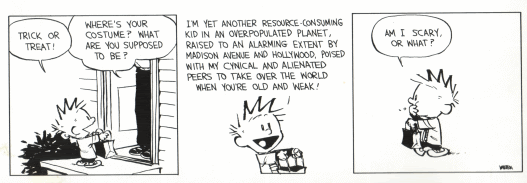Bill Watterson was the author of "Calvin and Hobbs." He was born in Washington D.C., where is father worked as a patent attorney; a profession centered around new ideas and change. Early on, his family moved on to Ohio where his mother became deeply rooted into the political structure of the town of Chagrin Falls. Watterson went on to graduate from Kenyon College with a degree in Political Science.
Using this information, it is not difficult to connect the childish act of trick or treating to the deeper meaning of global environment destruction and Calvin's role in doing so. Being that Watterson was accustomed to being around politics and an ever-changing society, as well as his own degree in Political Science, creating comics dpicting dark humor such as this were likely none other than quite easy for the man.
By using a medium such as cartooning and having his work published in hundreds, likely thousands of newspapers
 worldwide, Watterson was able to convey his message much easier and to a wider variety of people. Though his intentions may not be as such, Watterson may have played an influential role in changing people's beliefs in politics during the decade of "Calvin and Hobbs'" publication. Any "Save the Environment" picture such as the one at left can serve as a mode of persuasion, but nothing beats getting to someone's heart and hitting them with something that is both enjoyable and convincing at the same time.
worldwide, Watterson was able to convey his message much easier and to a wider variety of people. Though his intentions may not be as such, Watterson may have played an influential role in changing people's beliefs in politics during the decade of "Calvin and Hobbs'" publication. Any "Save the Environment" picture such as the one at left can serve as a mode of persuasion, but nothing beats getting to someone's heart and hitting them with something that is both enjoyable and convincing at the same time.Granted the picture at left does serve its own role as a persuasive tactic to keep our planet healthy and green, but it does not say nearly as much as Calvin can put into just a few words. In other words, the picture has a point, but it fails to present itself in a way that will make anyone care about what it has to say. "Calvin and Hobbs" had built in ethos appeal that created its own ability for reader believability. People grew up with the comic and were able to identify with it. Just as I can remember reading "Garfield" and "Family Circus" growing up, people that read "Calvin and Hobbs" understood what was going on, what to expect and what the true meaning was behind simple punch lines like, "Am I scary or what?"
Watterson, as an intelligent, well educated individual, knew what he was doing as an author and activist. Though his points may have been somewhat subtle, and in a medium that could be difficult to deliver the type of message he was trying to convey, Watterson was excellent in doing what he did best which is very accurately displayed in the comic I have chosen for my writing project two.
Works Cited
No Author. "Calvin and Hobbs". CalvinandHobbs.co.uk. 10/29/09. <http://www.calvinandhobbes.co.uk/history.html>.
No Author. "Calvin and Hobbs". CalvinandHobbs.co.uk. 10/29/09. <http://www.calvinandhobbes.co.uk/history.html>
